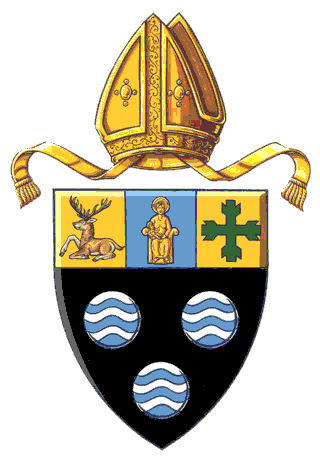 |
The Coat of Arms of the Diocese
The Arms were granted by the College of Heralds in 1884. In her George Ridding, Schoolmaster and Bishop, 1908, Lady Laura Ridding says, “They were carefully thought out by Dr. Ridding, in consultation with Archbishop Benson and Rouge Dragon.” Rouge Dragon, Pur suivant of Arms is one of the principal Officers of the College of Heralds. In The Book of Public Arms (Fox Davies) the Coat of Arms is described as follows:- “Sable, three fountains proper, a chief or, thereon a pale azure, charged with a representation of the Virgin Mary seated, bearing the Infant Christ or, between a stag lodged proper on the dexter side and on the sinister side a cross raguly vert.” It is pointed out that Davies has omitted to say that the Child is on the dexter, or right, arm. The Shield is coloured black, and the charges on it are three wells or fountains. In Heraldry wells are always shown as these are. These wells refer to the wells at Southwell. Southwell is full of wells, three of them being definitely connected with the Collegiate Church, and almost touching it. These three are:- “The Holy Well”, now under the Vestries. It is entirely enclosed by the building, and has been since the present Chapter House was built about 1291-1300. “Our Lady’s Well”, now filled in. This is close to the north wall of the Choir, which was built 1235-1240. “The Lord’s Well”, about 30 yards from the Church in what is now the garden of the Residence, the home of the Rectors of Southwell. “The Lord’s Well” is probably so-called since it was close to the house of the Lord of the Manor, the Archbishop of York. “The Chief” is the broad band at the top of the shield, coloured gold. On it are three charges which commemorate the foundation of the Diocese. The charge in the centre, the Virgin and Child, represents the Collegiate Church of Southwell, now the Cathedral. The other two charges represent, respectively, the Counties of Derby and Nottingham, as being the areas originally incorporated in the See. Lady Laura Ridding says that the Arms of the two counties were “Incorporated with the consent of their civic authorities.” Derby may have been given the place of honour, dexter, on the chief, since all the other blazonry was drawn from Southwell and Nottingham. The three charges are not used in the Arms of the Diocese exactly as they were originally used for the places themselves. In the case of the central charge, representing Southwell Cathedral, the ancient seal of the Chapter of Southwell, a drawing of which displays the Virgin with the Holy Child on her left arm, is probably of a date not later than the first half of the 12th century, perhaps of the time of Ealdred, Archbishop of York, 1061-1075, who gave the Canons separate Prebends. This seal was used in the deed of surrender to Henry VIII, AD 1540, and was broken up in 1588. But when this seal was adopted to represent the Cathedral Church of Southwell, a difference was introduced, the Virgin bearing the Child on her right arm, not on her left. With regard to the charge which represents the County of Derby, the Arms in general use by the county town are a stag seated on the ground with its head erect and surrounded by palings with a gate. When these arms were placed on the arms of the Diocese, a difference was made by altogether omitting the palings and gate. And lastly, touching the charge representing the county of Nottingham, the City of Nottingham has as its arms a ragged cross coronets vert, with three in gold. Here again a difference was made when the Diocesan Arms were constituted, the three coronets being left out. |


 Explanation
by the Rev F S Luxmore
Explanation
by the Rev F S Luxmore


